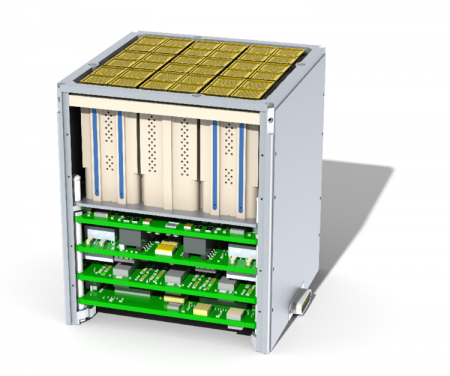March 26, 2017 – Accion Systems, a Boston, Massachusetts-based technology company, has developed a space propulsion system that uses electric fields and ions to move spacecraft. What makes this technology remarkable is its size and scalability. No bigger than a dime and capable of populating a spacecraft as small as a CubeSat and as large as a capsule with human occupants traveling through interplanetary space, the engine goes by the name TILE which stands for Tiled Ionic Liquid Electrospray.
Natalya Bailey, CEO of Accion, recently talked about the propulsion technology to a conference at MIT’s Sloan School of Management, describing it as scalable from as small as a nanometer to a multiple TILE array to serve as a propulsion system for large satellite systems. Seen in the image below each TILE features:
- a one-nanometer envelope
- 4,860 Newtons of thrust
- ability to operate up to 9 TILES simultaneously
- a non-toxic, unpressurized propellant
- no moving parts or valves
- fully restartable with adjustable throttling
- scalability
- customizability
TILE uses ionic liquid electrospray propulsion. That it uses an electromagnetic field to shoot charged atomic particles in the direction required by its operators. How it differs from other ion propulsion systems is this. TILE is really a thruster-chip assembly containing hundreds of emitters beaming ions powered by a salt-based solution propellant. Each TILE module is composed of 36 thruster chips measuring 10 x 10 x 12.5 centimeters (4 x 4 x 5 inches). The salt-based propellant gets stored in very small tanks. The electronics is powered by attached solar panels with battery. Ions get drawn from the propellant when the electromagnetic field is fired up. The ions are then ejected in a beam in the opposite direction from the satellite or spaceships planned direction creating forward thrust. TILEs can fire in two directions as can be seen in this YouTube posted video.
A small satellite weighing up to 200 kilograms can easily be propelled by 1 to 4 TILES. For larger objects, TILES can be strung together in an array to provide additional thrust. Because the TILES are lightweight, they are an attractive option for satellite and spacecraft builders. Accion believes a shoebox-sized array of TILES is all that would be needed for a voyage to Mars by a human-crewed spaceship.
In a recent article appearing in Bloomberg, Accion was rated as one of 50 startup companies deemed most promising to investors looking at emerging technologies and innovative business plays. I would suspect we will see this technology deployed in the very near future. The company states first flight will happen in 2018 and suspects that TILE technology will be used in the near future for satellites and spacecraft in orbit to raise, maintain and de-orbit, extending mission lifetimes without expending costly and toxic propellants into near space. And although ion propulsion can’t get you off the ground and out of Earth’s gravity well, once up in space, it becomes an excellent propulsion alternative to chemical-fuelled rocket engines.
















